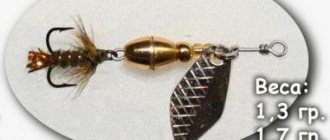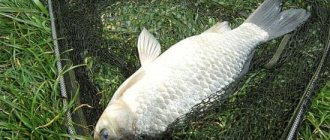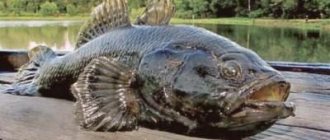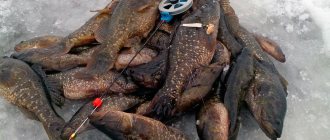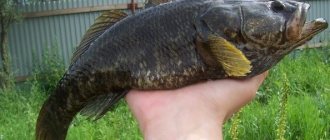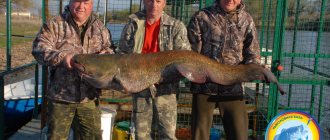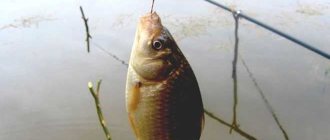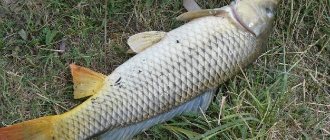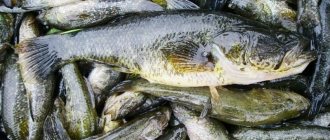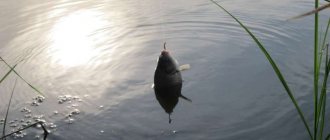Author of the article
Andrey Soprykin
Professional fisherman with 23 years of experience.
Articles written
85
Each time of year has advantages and disadvantages for chub fishing. However, in the fall it is more exciting and effective to catch it. When the weather becomes cool, the predator prepares for winter and becomes more active. He begins to experience the so-called “zhor.” During this period, fish respond well to various baits if everything is done correctly.
Rice. 1. During autumn fishing you can catch very large individuals.
Features of fishing in autumn
We recommend watching a very useful video about catching rotan:
Fishing will be effective if you understand the behavior of the fish and know what it eats. The chub is considered a conditional predator, i.e. he can eat food of both plant and animal origin. In autumn, he prefers the second option, because... he needs to gain strength for winter.
The chub is cautious, but if it does not move, it is not afraid of the presence of a person. The most important thing is not to make noise, and also to ensure that the shadow of the silhouette is not on the water. It is best to cast while hiding. You need to throw the bait to a depth (4-6 m), where the predator lives in the autumn and rises only to find food. Of course, there is a chance of catching it on the surface, but much lower.
Expert opinion
Valery Andreevich Sizov
Professional fisherman with 35 years of experience
Note! Chub bite well in September-October. In late autumn, it lies in holes at the bottom and comes up very rarely for food. There is practically no chance of catching him. Therefore, it makes no sense to go fishing before spring if the target is this particular predator.
How rotan behaves in winter
The very first high activity of rotan in winter appears on closed reservoirs at the beginning of the season, when the ice has just frozen; on open reservoirs, the ice becomes a week or two later, so if you get bored of catching rotan on lakes, you can safely move to other reservoirs. In the middle of winter, rotan is inactive and takes bait very reluctantly.
Later, when the ice thaws, when it becomes like during the first severe frosts, rotan again shows its former activity. When the ice is thin, rotan, both large and small, gathers closer to the shore; after one or two weeks, when the ice reaches a thickness of 14-16 centimeters, large specimens of rotan go to the depths, trying to stay on the edge of underwater thickets, in snags, while small specimens also continue to be in shallow water.
Rotan is not afraid of complete freezing of a reservoir, since due to its physiological characteristics it is capable, when freezing in ice, of forming a “gas chamber” around itself, which contains oxygen. After which the fish goes into suspended animation, emerging from it when the ice thaws.
It is noteworthy that rotan is not afraid of the noise of an ice ax, so even after drilling a hole directly above its head, there is a chance to immediately pull out the first catch.
After the ice reaches a thickness of more than 30 centimeters, rotan goes into the pits, where you should look for it among the thickets of grass. It should be remembered that small individuals live in packs, while large ones hunt alone. Rotan is most active during the daytime (from morning to lunch inclusive), after which the bite sharply worsens, and at night you may not catch anything at all.
The most successful weather for winter fishing will be a cloudy day with high atmospheric pressure, since rotan does not like sunlight. When the weather changes abruptly, the fish loses its appetite, so you should choose a day from a stable weather week for fishing. During the full moon, rotan may not take bait at all, while immediately after the moon changes the situation changes dramatically.
Where to look in the fall?
Before catching chub , you need to decide on the most promising place. In autumn, the predator moves from areas with moderate and fast currents to calmer ones. For example, in the zones of contact between the main flow and the backwater. It can also be found in quiet areas, where tree branches hang over a pond, near dams, bridge supports, etc.
Rice. 2. The ideal place for fishing is a small mountain river with vegetation along the entire bank.
Catching large rotan in winter
Rotan is a predatory fish, capable of cannibalism; its hunting method is very similar to perch (it rushes after prey from the thickets). In winter, rotan bites well at the beginning, when the first ice appears on the water; rotan takes bait a little less well at the end of winter, when the ice is coming off. If you have an echo sounder, it is very easy to identify a goby underwater - if you drilled a hole and there is a fish next to it, it is definitely a rotan. Due to the poor sensitivity of the lateral line, rotan weakly senses water vibrations even in its immediate vicinity, which, if the fishing location is successfully chosen, leads to a quick bite.
It is necessary to drill several holes (8-10) since in one hole, even with the right choice of bait, you can end up with nothing. Holes for fishing should be made from the periphery of the reservoir to its center, equally distant from each other. Knowing the location of vegetation at the bottom of a lake or pond will be a huge advantage; then you should drill holes at the edge of the underwater thickets.
If there is no bite on one hole for 3-5 minutes, you need to move on to the next one. Transitions can also be made from the edge of the reservoir to the center. Those holes on which there were no bites should not be abandoned for the rest of the fishing period, since at lunchtime the fish can move and more rotan can be caught on “empty” holes than on working ones.
Video on how to catch rotan in winter on the first ice:
Tackle and bait for spinning fishing in autumn
For autumn chub fishing, it is recommended to choose gear with the following characteristics:
- A durable but lightweight rod, which is close to the ultralight type (test up to 14 g, length 2.1-2.7 m depending on the fishing distance). If you plan to cast at short and medium distances, it is recommended to choose semi-parabolic models. If the distance is large, then it is better to give preference to an elongated rod with a fast action.
- Inertia-free reel with uniform stroke and good laying. The spool size is 2000-3000 with an additional ratio of 5-5.5:1.
- The thinnest, but at the same time strong fishing line (the predator will be very active when hooking and can easily break off a weak one, especially a large individual). The cross-section can be from 0.1 to 0.12 m with a breaking load of up to 5-6 kg.
- Small baits weighing up to 5 g. It is recommended to take several pieces of each bait model with you when fishing. Because after the most effective one is selected, it may break or get lost. Especially in areas with dense vegetation. Because of this, you will have to interrupt fishing; it will be a shame if this happens during a good bite.
What does a predator bite on in the fall from natural bait:
- caterpillars;
- maggots;
- bloodworm;
- pearl barley;
- corn;
- small meat pieces;
- minnow and bleak fry;
- small frogs.
As practice shows, in the autumn the chub bites best on small wobblers. Cranks and fats are more effective. These are solid baits with convex sides, with good action with any type of retrieve.
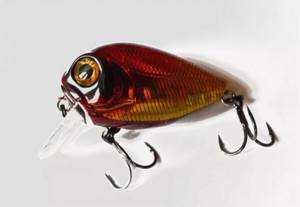
Rice. 3. Crank and fat.
Expert opinion
Valery Andreevich Sizov
Professional fisherman with 35 years of experience
Note! Fishing with vibrating tails and spinners also shows good results. Their natural movement through the water attracts predators. However, before you can understand what the predator bites best on, you will have to try several bait options. The type of fish the fish will choose is influenced by the surrounding conditions, weather conditions, the size of the chub, etc.
Features of gear depending on the month
The size of the bait should not exceed 4-5 cm. In early autumn, it is recommended to give preference to wobblers of bright, golden or silver colors. In October you can switch to darker colors. For example, use minnow-type wobblers in black or dark brown. In cold water they are able to attract even not very active individuals. It is advisable to take with you models designed for different depths.
In early autumn, you can also use small silicone tips. They show greater effectiveness in early September, while the weather is still warm. As practice shows, a predator attacks such bait immediately when it falls into a body of water, so you need to notice this in time and make a sharp hook.
Late autumn is best for fishing with spoons. It is recommended to choose turntables, the most important thing is that the petal rotates evenly, without stopping. If oscillators are used, then the wiring should be with jerks, pauses, and changing the speed of the wiring.
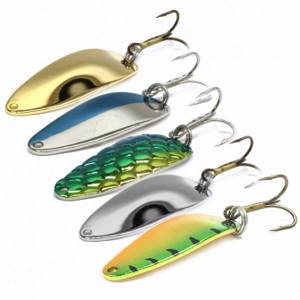
Rice. 4. Turntables and vibrators.
Catching rotan using a spinning rod.
There are many ways to catch rotan in the fall, but the most interesting is spinning.
This gear provides significant advantages. Firstly , the ultralight spinning rod weighs extremely little and does not take up much space in the stowed position. Secondly, everything you need : bait, spare fishing line and more, easily fits in a small bag.
Thirdly, with a short spinning rod you can fish in difficult conditions of overgrown banks. And finally, spinning rods, especially ultralight ones, bring a lot of pleasure when fishing.
To catch rotan, long casts are not needed; this fish is not shy and can be caught almost “under your feet,” so when placing the bait you need to bring it as far as possible to the shore. Often the rotan is taken when the angler removes the bait from the water. The most preferred fishing places are the border of aquatic vegetation with water, as well as windows of clear water, among continuous vegetation.
After casting, the bait is passed almost along the surface of the water or in the surface layer. Uniform wiring of rotan does not excite, so it is worth using twitching wiring when the bait moves unevenly with pauses.
It is better to select exactly what tempo and what duration of the pause on the spot experimentally, since at different times and seasons rotan exhibits unequal activity. Very often, an angler can personally observe how a fish chases the bait and, from experience, the rotan makes a throw at the prey precisely during pauses.
If there are windows of clear water, you should not cast directly into them, but it is better to do it further so that the bait already passes through the window with exciting wiring.
If the pond is completely overgrown with duckweed , you should not leave it immediately. There is definitely rotan there and you can do the wiring directly on top of the duckweed, making paths in it. This method simply amazingly excites this fish, and the fisherman can observe with his own eyes how the sleeper rushes at the prey.
The bite of rotan is felt very well , it takes sharply and strongly. You shouldn’t delay hooking, as he can swallow the bait deeply and it will be difficult to get it out. When fished out, rotan gives the impression of a large fish, and when removed from the water, it behaves surprisingly humbly.
Conclusion:
- Fishing for rotan in the fall is very promising and brings results in any weather, at any time of the day.
- Rotan can be caught even in those reservoirs where the presence of any fish is not expected.
- Rotan is an ideal fish for beginners who are starting to master some kind of fishing method. Along with tackle management skills, a beginner will receive moral satisfaction from a virtually guaranteed catch.
- Catching rotan with an ultralight spinning rod is the most interesting; even experienced fishermen do not disdain it.
Features of fishing with a float rod
Many fishermen prefer a regular float rod to a spinning rod. This tackle is perfect for catching chub in the autumn. It must have the following characteristics:
- a fly-type fishing rod, about 6 m long, so as not to frighten off a cautious predator;
- fishing line with a cross section of 0.22 mm;
- hooks No. 4 (according to European standard);
- float approximately 4 g;
- leash about 70 cm.
Before catching chub with a float rod, you need to choose an effective bait. Good results with this type of gear are shown by:
- various beetles, worms, larvae;
- grasshoppers;
- dragonflies;
- maggots;
- bloodworm.
Fishing technique:
- Select a suitable site.
- Cast and lower the bait. If a predator is nearby, he will definitely notice her.
- If the fish does not bite for more than 15-20 minutes, there is no point in waiting any longer. Need to change location.
As mentioned earlier, the chub is a very cautious fish, so when fishing you need to be quiet, do not catch tree branches with your fishing rod, and turn off the sound on your mobile phone. It is recommended to leave the car and any other vehicle away, and get to the river on foot so as not to spook the fish.
Baits and baits
Rotan is a predator, but with pleasure it attacks everything that moves, not only edible things, but also artificial baits.
Animal bait
- worm;
- bloodworm;
- maggot;
- various insects;
- meat (anyone's).
Plant attachments
- various cereals;
- corn;
- peas.
Artificial baits:
- twisters;
- artificial bloodworm;
- artificial maggot;
- rubber worms.
Secrets to Successful Float Fishing - 17 Tips to Improve Your Float Fishing.
The Ultimate Guide to Float Fishing.
How to choose the right float rod - read the guide.
Features of using donkeys
Donka can be used as an independent fishing technique or combined with spinning or fishing rod fishing. In the second case, the efficiency will be higher. The following devices can be used as a donkey:
- Supply. This is the most basic device that is perfect for beginner fishermen. You can do it yourself right on the pond. To do this, you only need a flexible pole, to which a reel with fishing line (at least 3-5 m), a sinker (flat and heavy) and hooks (No. 1-7) will be attached.
Rice. 5 The principle of installing the supply at depth.
- Coil. If fishing is carried out from a boat, then such a donka can be secured to a snag or tree on a steep bank. If there is no swimming device, then it must be hung on a spinning rod or a rigid fishing rod.
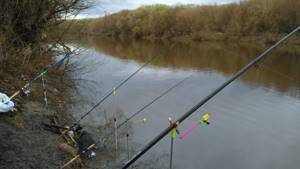
Rice. 6. To make the donk attached to the fishing rod more effective, you need to install several pieces at once. If you don’t have that many bits, you can use flexible rods.
- Donka with a feeder. This means attracting a predator with aromatic plant ingredients (for example, cake). It is advisable to use such a trap only in warm weather, because when it gets cold, the predator prefers food of animal origin. He will not pay attention to additional feeding.
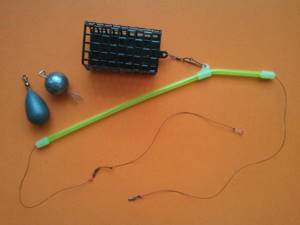
Rice. 7. Bait is placed on the hooks, and plant cake is placed in the feeder, which attracts the predator with its aroma. He senses it ten meters away.
